
The Saigon Tax Trade Centre today
Once the epitome of colonial chic, the former Grands Magasins Charner (GMC), better known as the Saigon Tax Trade Centre, was the city’s only surviving colonial-era department store. Located on a prime site in one of Hồ Chí Minh City’s numerous “đất vàng” (gold land) areas, it is now closed and awaiting demolition to make way for a 43-storey tower block.
The Grands Magasins Charner was not the first department store in the city – that honour went to the Au Nouveautés Catinat, a store founded in 1887 on place Francis Garnier (Lam Sơn square) by Corsican entrepreneur Lucien Berthet. But following its grand opening in 1924, the Grands Magasins Charner became the place to shop in Saigon.
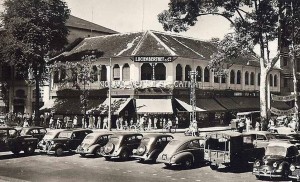
The earlier Au Nouveautés Catinat department store (1887)
At the turn of the 19th century, the site on which the Saigon Tax Trade Centre stands housed premises which were occupied by the Direction de l’Agriculture et du Commerce and the editorial board of the bimonthly Bulletin de la Chambre d’Agriculture de Cochinchine.
These premises – 135 boulevard Charner – later became home to a variety of other tenants, including the Syndicat des Planteurs (Planters Syndicate), the Société de protection des jeunes métis (Society for the Protection of Young Mixed-race Children) and the retail company, Bresset et Cie. During the World War I years, the automobile company Établissements Claudius Perrin also set up business here, selling Renault and de Dion-Bouton motor vehicles and Michelin tyres. However, when the site was acquired by the Union Commerciale Indochinoise et Africaine in 1921, existing tenants were moved out and the site was cleared.
Later that same year, the Union, which had just established a subsidiary known as the Société Coloniale des Grands Magasins to look after the running of its Grands Magasins Réunis in Hanoï, embarked on the construction of an even bigger luxury department store in Saigon. Construction got under way in 1922 and on 26 November 1924 the Grands Magasins Charner was inaugurated.
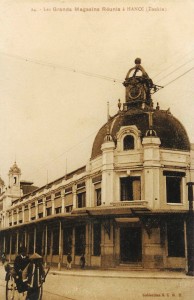
The Grands Magasins Réunis Hanoï
A report in the Écho annamite newspaper of 27 November 1924 described the opening ceremony which was presided over by Mr Eutrope, representing the Governor of Cochinchine.
As “a huge crowd” gathered outside to peer into “the gleaming windows artistically filled with the pride of French industry,” invited guests were greeted at the door by company staff, “immaculate in their tuxedos, with the refined politeness of the perfect trader.”
The guests were treated to a guided tour of the new store, which comprised departments of perfumery, jewellery and silverware, millinery, lingerie, fabrics and silks, haberdashery, shoes, leather goods, porcelain, furnishings, hardware, toys and sports equipment, music, household goods, food, wines, spirits and tobacco, pharmacy, stationery and books, and – de rigueur for the wealthy colon – weapons, ammunition and hunting accessories. There was even a salon de manucure, a travel department and an in-house photographic studio.
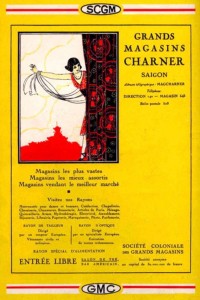
A 1927 advertisement for the Grands Magasins Charner
The Écho annamite reporter described the jewelry department as being “like one of those dream lands described in the Arabian Nights…. then, almost without transition, you are transported into the less futile domain of knowledge and thought – it’s the book department.”
“Elsewhere,” continued the breathless reporter, “gourmets will lick their lips in delight as they contemplate bottles of champagne of the most renowned brands and wines of the best vintages, proudly wearing their labels and stacked in rows like soldiers on review, alongside cans of biscuits and conserves piled in pyramids.”
The toy department seems to have made a particular impression, with its “dolls which say ‘mama, papa,’ or close their eyes when they are laid on their backs, toy figures which play cymbals when you pinch their bellies, stuffed animals which get up on their hind legs when you squeeze their attached rubber bulbs, model railways, clockwork cars with rubber wheels, etc etc.”
However, the reporter then decided to forego the other departments and head straight for the “luxurious salon de thé,” with its “excellent champagne, cookies, cakes and tasty sandwiches.”
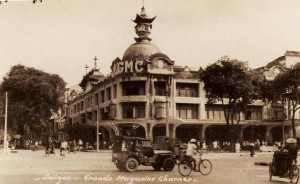
A view of the Grands Magasins Charner in the late 1940s
At the conclusion of the tour, the guests were seated around small tables where they sipped champagne and nibbled on pâtisserie while listening politely to speeches from Mr Eutrope and Mr Ribupe, representative of the Société des Grands Magasins, who explained that in order to ensure the supply of all the highest-quality goods, his company was affiliated with the Société Française des Nouvelles Galeries (SFNGR), “one of the most perfect department store companies which exist in France.”
With its slogan “Loyalty is our strength,” the Grands Magasins Charner boasted of being “Sales agents of the best global brands such as Oméga watches, Jaz alarm clocks, Seymour shirts, Gillier stockings, Heyraud shoes, Lesquendieu beauty products and Zeiss-Ikon cameras.”
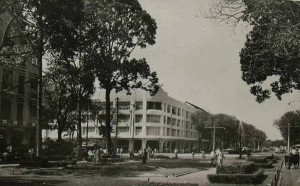
A view of the Grands Magasins Charner in the early 1950s after it was remodelled
However, its speciality throughout the late colonial period seems to have been hunting supplies – several advertisements of the 1920s and 1930s devote considerable space to the promotion of leather gun cases with adjustable shoulder straps, leather cartridge cases, cartridge belts and hammerless repeating rifles.The store even published its own “special catalogue of weapons and hunting supplies.”
The 1937 Guide touristique général de l’Indochine described the Grands Magasins as “the best stocked store in Indochina, with the widest choice, incomparable price and all of the facilities one would find in a Paris department store.”
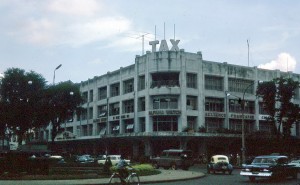
The Saigon Tax Trade Centre in the 1960s
With its central location, the roof of the building was selected in October 1925 by the port authority as the location of “a powerful siren which announced the arrival of the courriers de France.”
The Grands Magasins roof dome originally incorporated a clock tower, but some time after 1948, that was removed in order to make way for the construction of a third floor to provide additional retail space.
The Grands Magasins Charner makes a brief appearance in Graham Greene’s novel The Quiet American as “the big store at the corner of the Boulevard Charner,” outside which British correspondent Thomas Fowler is invited to stand and witness the events of “Operation Bicyclette”– which conclude with a bicycle bomb explosion in the fountain pool in the middle of the Bùng Binh Sài Gòn traffic circle. This incident was featured in the first (1958) film version of The Quiet American.
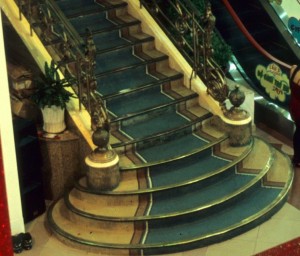
The shop’s beautifully designed main stairway (photo courtesy http://commerces-immarcescibles.blogspot.com)
In around 1960, the Grands Magasins was renamed the Saigon Tax Trade Centre (Thương Xá Tax Sài Gòn) when its owners began renting out space to individual merchants.
After Reunification, the building initially became an exhibition centre for industrial machinery, but in 1981 it was re-established as the City General Department Store (Cửa hàng Bách hóa Tổng hợp Thành phố). The building was renovated in 1995 and in October 1997 its name was changed to Saigon General Retail Company (Công ty Bán lẻ Tổng hợp Sài Gòn) by its owner, the Tổng Công ty Thương mại Sài Gòn (SATRA). However, early the following year the old name Thương Xá Tax Sài Gòn was reinstated on the façade.
Last renovated in 2003, the building retains many of its original interior features, notably its beautifully designed mosaic stairway with decorative wrought iron railings.
Since its closure in September 2014, the building has been the focus of a high-profile campaign by a local conservation group to persuade the authorities to preserve its magnificent mosaic staircase and elements of the original GMS facade design in the new tower block which will replace it.
UPDATE: In December 2014, the Hồ Chí Minh City People’s Committee approved a recommendation from the HCMC Director of Planning and Architecture that the lobby. mosaic stairway and some exterior design features of the Saigon Tax Trade Centre should be preserved and incorporated into the new building. The interior features to be preserved include: “the main lobby and staircase from the ground floor to the 1st floor and the original decorative mosaic-tiled staircase and associated decorative details, banisters and handrails from the original building,” while the exterior features to be preserved include “the canopy extending over the sidewalk and some of the architectural contours of the original building.” However, the mosaic stairway would have to be removed, stored and reinstated later. Contrary to the advice given that this would require specialist conservation input, local university students were then employed to archive and remove the mosaic staircase. The building was finally demolished in 2016 and in 2018 the site still remains empty – nothing more has been heard of the priceless mosaic staircase.
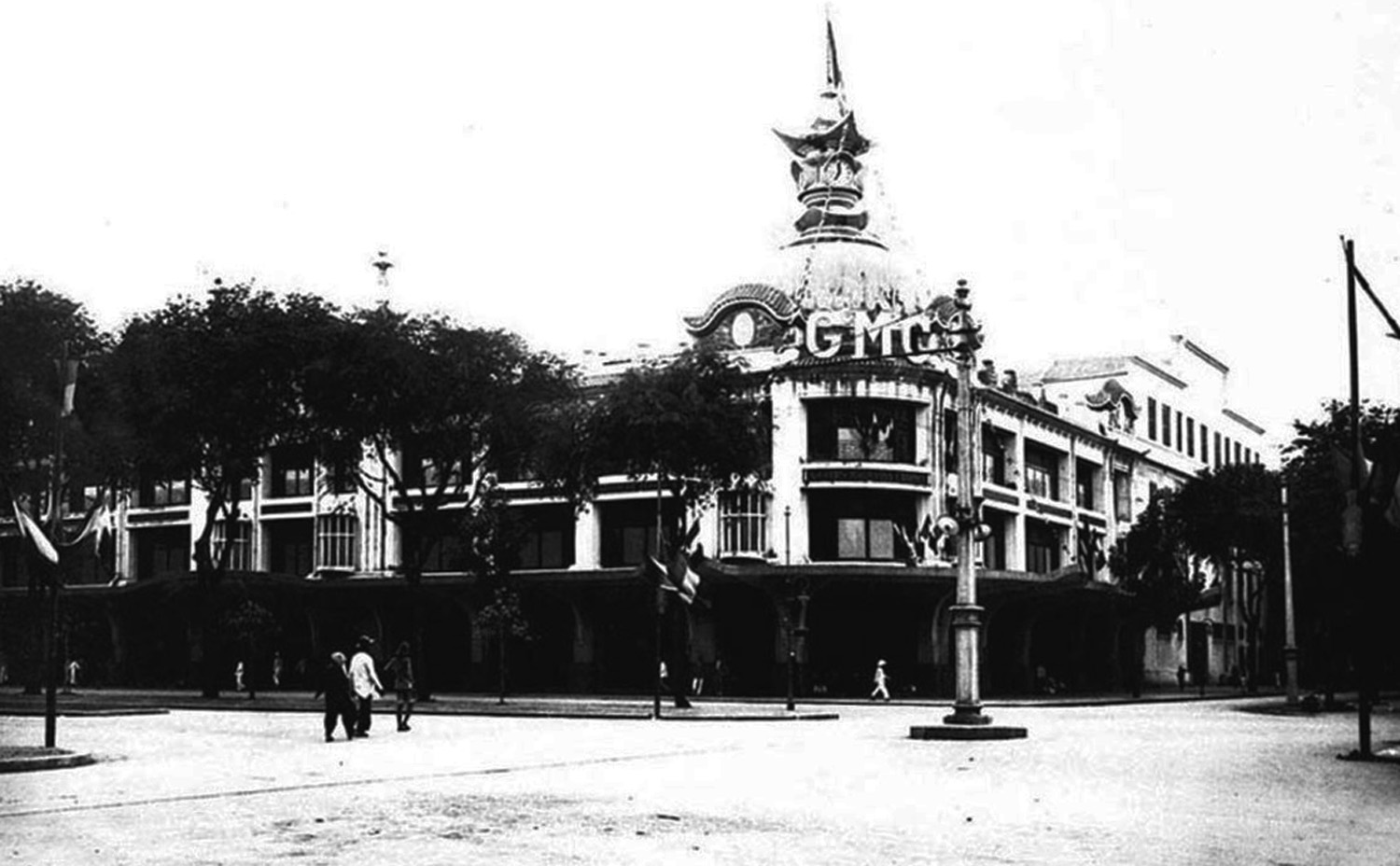
A 1920s view of the Grands Magasins Charner
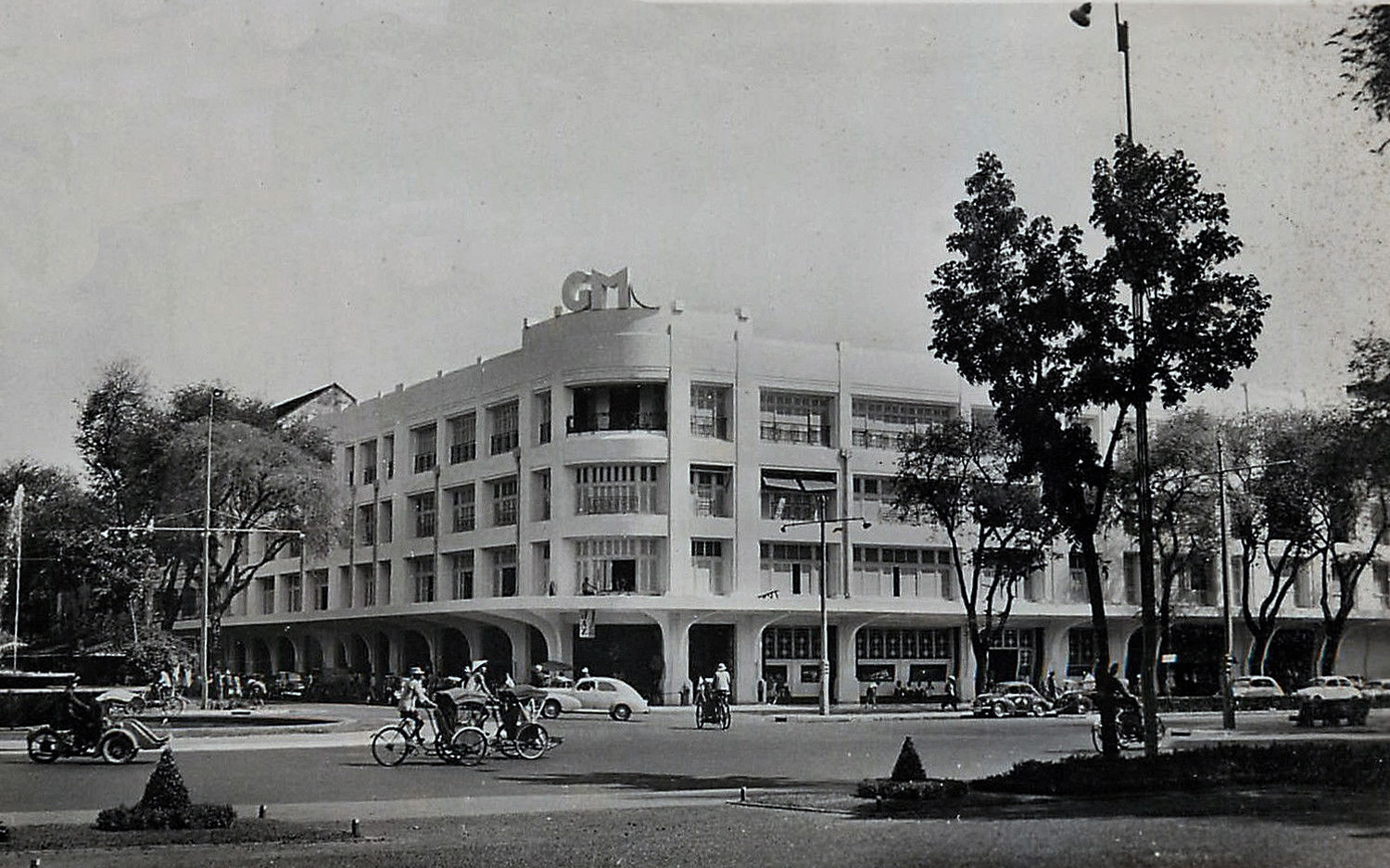
A 1950s view of the Grands Magasins Charner
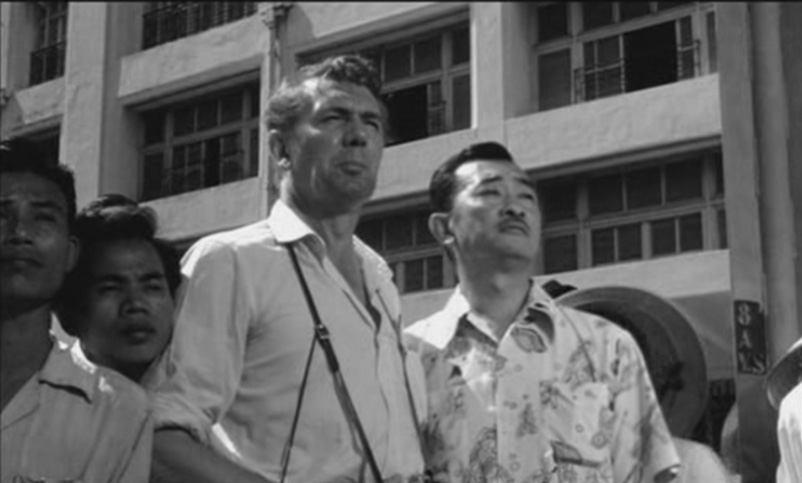
The building was featured in The Quiet American (book and first film) – a still from the 1958 film of The Quiet American (© Figaro/United Artists)
Tim Doling is the author of the guidebook Exploring Saigon-Chợ Lớn – Vanishing heritage of Hồ Chí Minh City (Nhà Xuất Bản Thế Giới, Hà Nội, 2019)
A full index of all Tim’s blog articles since November 2013 is now available here.
Join the Facebook group pages Saigon-Chợ Lớn Then & Now to see historic photographs juxtaposed with new ones taken in the same locations, and Đài Quan sát Di sản Sài Gòn – Saigon Heritage Observatory for up-to-date information on conservation issues in Saigon and Chợ Lớn.


Dear Mr. Doling:
Your article mentions that the construction of GMC was started in 1922 and not until 1924 was the building inaugurated. This is intriguing as many believe this building dates back to as far as 1880. Would you care to elucidate this notion?
Thank you and regards,
Daniel Vu
Hi, thanks for your query.
There are references to this in various French sources, eg:
1. 1922 Tonkin pittoresque. Souvenirs et impressions de voyage. 1921-1922
“Cet ouvrage a été écrit en 1922 avant l’ ouverture a Saigon des Grands Magasins Charner”
2. 1925 Les Potins de Paris (Paris. 1918) 1925/06/14 (A8,N2131)
UNION COMMERCIALE INDOCHINOISE ET AFRICAINE: “Le fonds du portefeuille de la Société est constitue par une large proportion du capital de la Société Coloniale des Grands Magasins. Il était donc intéressant pour les actionnaires de l’U.C. I.A. de savoir que cette affaire se développe dans des conditions satisfaisantes. Le Grand Magasin, dont la construction était entreprise depuis deux ans et demi à Saigon, a été inauguré fin novembre dernier [ie Nov 1924] en plein succès.”
3. 1924 L’Écho annamite, 27 novembre 1924
“Inauguration des Grands Magasins Charner: Hier, à la tombée de la nuit, une foule immense se pressait autour des élégants Magasins Charner, rutilants de lumière et dont l’imposante architecture trône dans ce coin select de Saïgon-la-Perle comme un coin de la ville Lumière surgi du sol sous l’effet d’un coup de baguette magique de cette fée française: la Société coloniale des Grands Magasins.” You can read the rest here http://gallica.bnf.fr/ark:/12148/bpt6k7554142x/f1.image.r=%22Inauguration%20des%20Grands%20Magasins%20Charner%22.langFR
However this in no way diminishes the heritage value of this building.